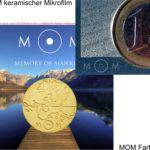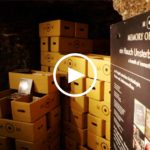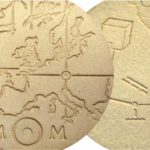Memory of Mankind builds Humanity´s largest time capsule in Hallstatt
A Thousand Books for a Million Years – The 1000 most important books stored on ceramics
Hallstatt (Austria) – The Memory of Mankind Foundation (MOM) was founded with the goal of preserving an image of our present far beyond the digital age. For this purpose, ceramic-based data tablets are stored deep in the salt mine of Hallstatt (Austria) in the Memory of Mankind Archive. Memory of Mankind launches its first international campaign, A Thousand Books for a Million Years, to select and store on ceramic microfilm tablets the 1000 most important books of humanity. Further campaigns on painting, architecture, technology and music are to follow.
At the beginning of the Memory of Mankind project, Martin Kunze posed some provocative questions: Will we be able to access the huge data volumes of our digital age in 100, 1,000 or 10,000 years, if highly sensitive hard drives last only about 10 years and we already have problems today to read floppy disks or CD-ROMs? – Does our digital society not threaten “Digital Alzheimer” or a “Digital Dark Age”? – Which storage medium is resilient enough to last for 1,000,000 years or more?
 The solution to the last question was obvious for the ceramic artist Martin Kunze. The oldest data carriers of humanity are more than 5,000 years old cuneiform tablets made of clay. So, in recent years, he developed a ceramic color printing process and a ceramic microfilm tablet that can store up to 1000 book pages on a single ceramic tablet sized 20x20cm / 8×8 inch. These modern day “clay tablets” made of high-performance ceramics are hard as sapphire, water or temperatures up to 1,500 C° and even acid cannot harm these data carriers.
The solution to the last question was obvious for the ceramic artist Martin Kunze. The oldest data carriers of humanity are more than 5,000 years old cuneiform tablets made of clay. So, in recent years, he developed a ceramic color printing process and a ceramic microfilm tablet that can store up to 1000 book pages on a single ceramic tablet sized 20x20cm / 8×8 inch. These modern day “clay tablets” made of high-performance ceramics are hard as sapphire, water or temperatures up to 1,500 C° and even acid cannot harm these data carriers.
Finally the optimal storage place for the largest time capsule of humanity was found in the oldest salt mine in the world, in Hallstatt-Austria, where salt has been mined for more than 7,000 years. The salt mine itself is protected by international agreements as part of the UNESCO World Heritage region Hallstatt-Dachstein / Salzkammergut.
 Renowned institutions such as the Natural History Museum Vienna, the Art History Museum Vienna, the University of Vienna, the OECD’s Nuclear Energy Agency and the Swedish Nuclear Fuel and Waste Management Corporation have stored data in the MOM archive. But also many private people from all over the world already use the MOM archive to keep their story and stories in picture and text and thus contribute to the first “Bottom Up Told History”.
Renowned institutions such as the Natural History Museum Vienna, the Art History Museum Vienna, the University of Vienna, the OECD’s Nuclear Energy Agency and the Swedish Nuclear Fuel and Waste Management Corporation have stored data in the MOM archive. But also many private people from all over the world already use the MOM archive to keep their story and stories in picture and text and thus contribute to the first “Bottom Up Told History”.
A Thousand Books for a Million Years is the first in a series of campaigns in which supporters can actively participate in building the MOM archive. In cooperation with universities, the most important books in a language area will be identified by bestseller lists, internet rankings and citations. Everyone can also submit their own suggestions on the MOM website. The selected books will then be placed on ceramic microfilm tablets and stored in MOM’s vault in the Hallstatt salt mine.
 How can the MOM archive ever be rediscovered in some far distant future? – A treasure map in the form of a round ceramic token (diameter approx. 6 cm/2.4 in) shows the exact position of the MOM archive by means of landmarks. The MOM tokens are sent to every participant in the crowd funding campaigns. In the distant future, the scattered tokens around the world will show a future Indiana Jones the path to the MOM archive knowledge treasure.
How can the MOM archive ever be rediscovered in some far distant future? – A treasure map in the form of a round ceramic token (diameter approx. 6 cm/2.4 in) shows the exact position of the MOM archive by means of landmarks. The MOM tokens are sent to every participant in the crowd funding campaigns. In the distant future, the scattered tokens around the world will show a future Indiana Jones the path to the MOM archive knowledge treasure.
The Hallstatt salt deposits originated about 240 million years ago from the salt of the ancient ocean, Tethys. The MOM archive is thus, in a figurative sense, a message in a bottle in the ocean of time, which is rediscovered in 1,000, 10,000 or 1,000,000 years.
Help fill Humanity´s largest time capsule with content. Which book would you keep for eternity?


